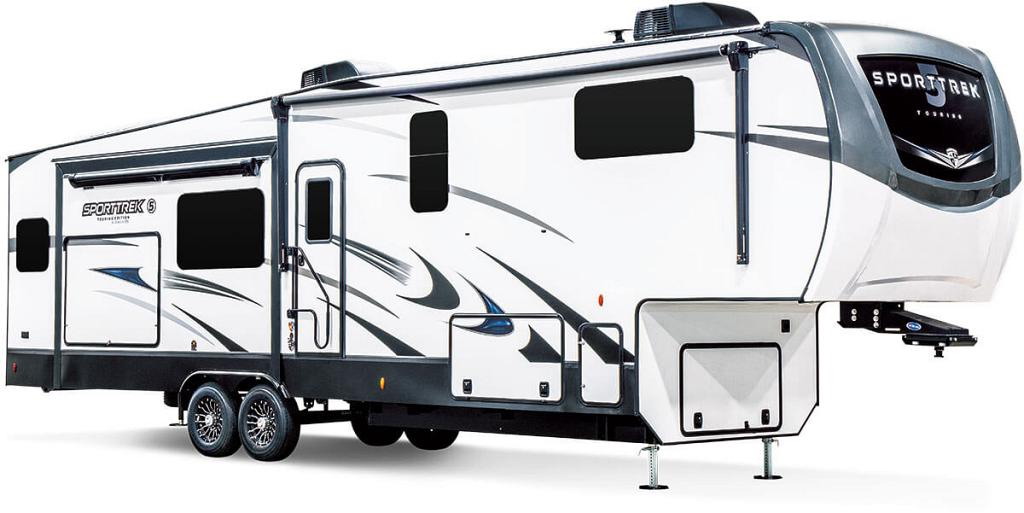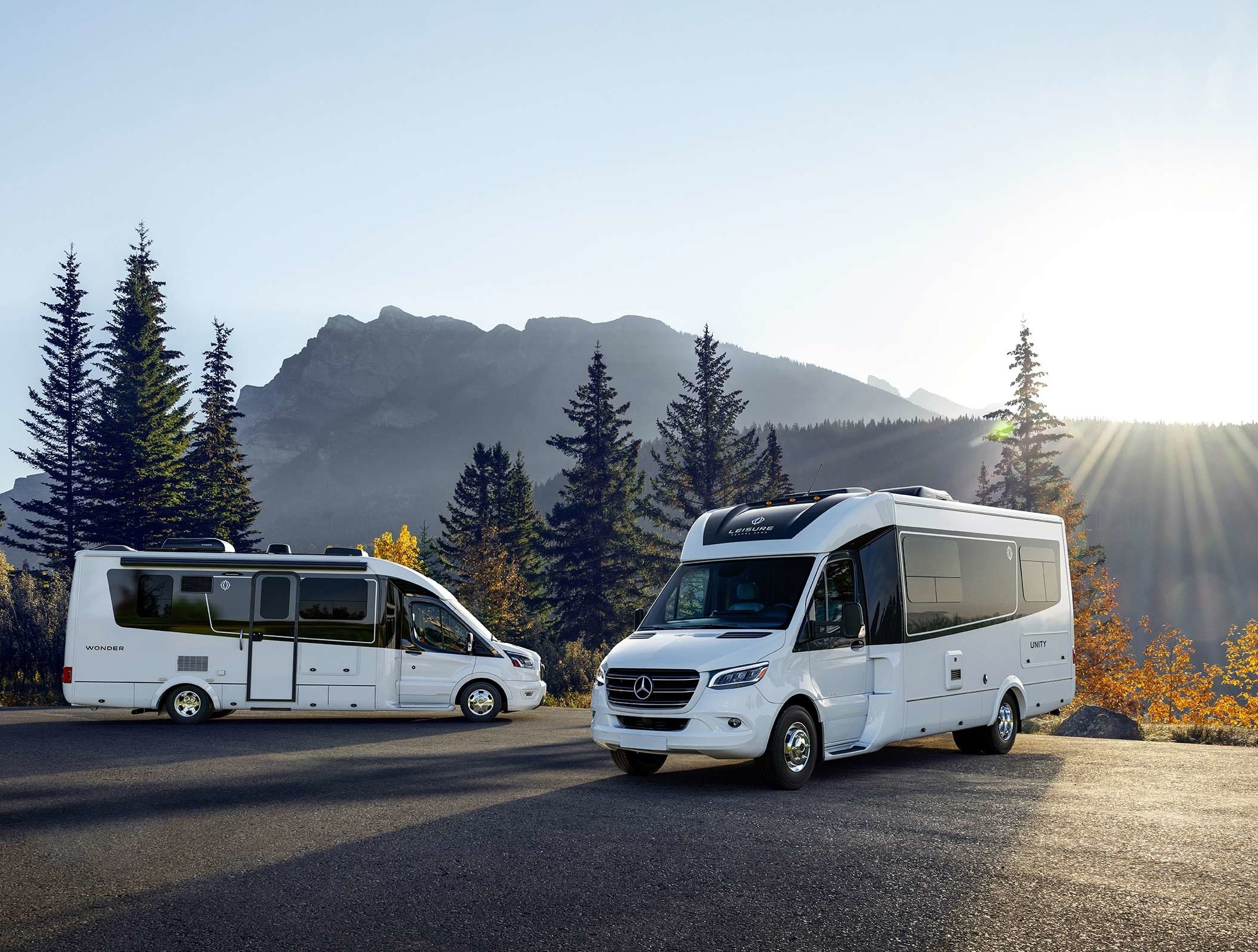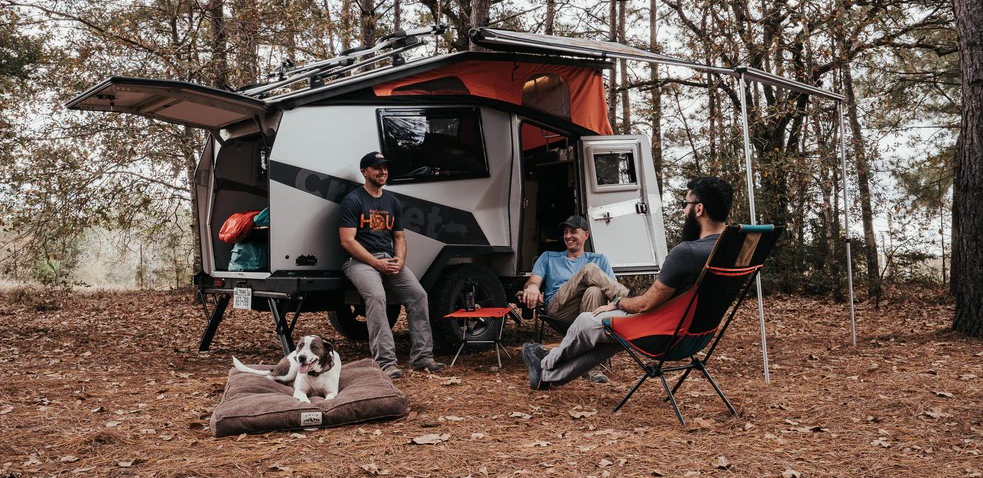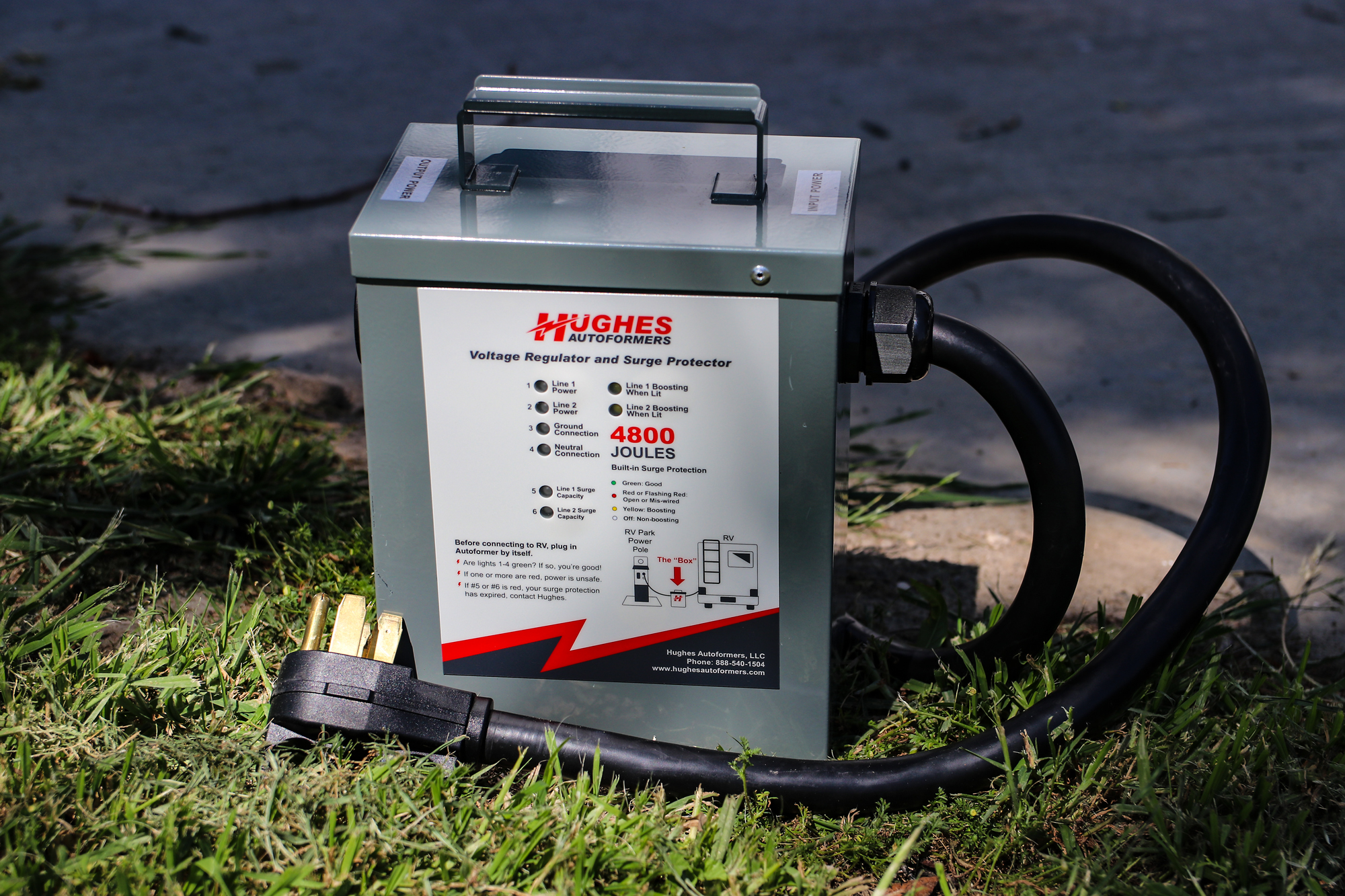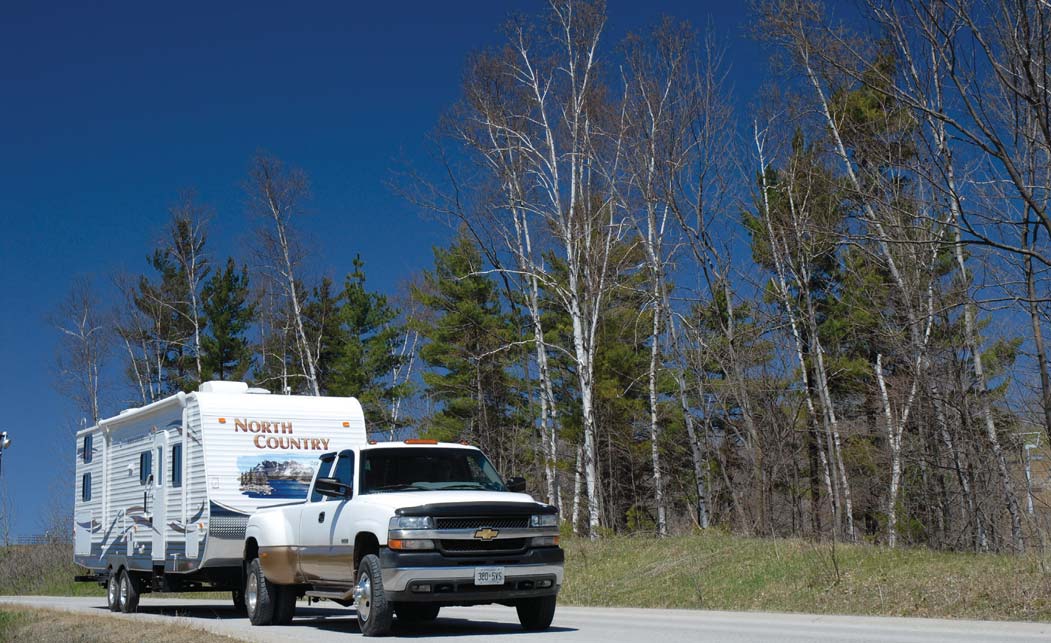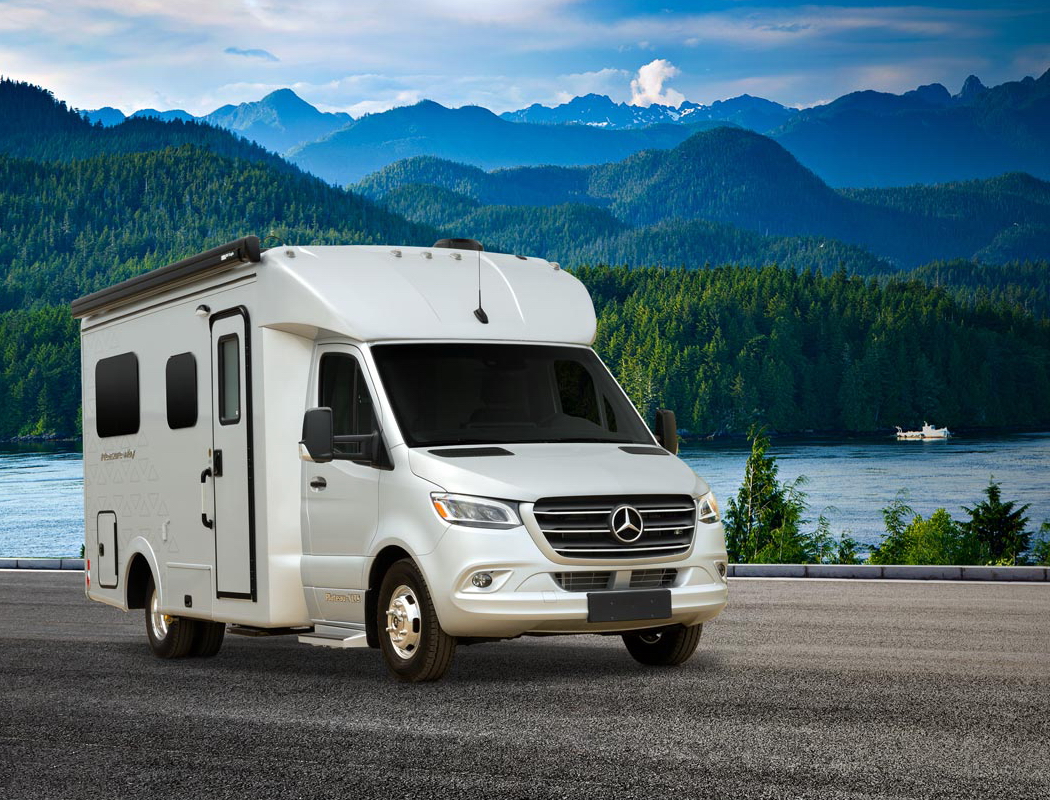Today we debate the merits of half-ton and three-quarter-ton trucks… next time we will discuss the merits of duallies!

A few years ago, I visited a dealership in the US, and as I was chatting with the service manager on the lot, a customer pulled up in a new three-quarter ton 4×4 with live axles front and rear and a 34’ travel trailer on the back. The hitch set up was terrible; the 800-pound torsion bars had almost no effect, there was no sway control, and the hitch ball was a foot behind the bumper. The Service Manager glanced at the rig, told the customer “that should tow it” and the customer headed off on a cross-country trip.
I asked the Service Manager what the customer’s previous vehicle was, and he replied “a Z71 GM pickup – but it was all over the road”. In those days a Z71 was pretty good truck to tow with – it had slightly heavier springs than the standard model, and it came with Bilstein shocks. With the tires changed and correct hitch set up it was a far superior tow vehicle to the tall gangly truck this customer had just hitched to his travel trailer. The new three-quarter ton likely felt better on some level, but it in this case, with a poor hitch and suspension set up it would have been a false sense of security as there would be no depth of control.
On the internet RV towing forums nothing raises more controversy than the half- vs three-quarter ton truck debate. As far as brands are concerned, each truck has its strengths and weaknesses, so choosing the “right truck” is a matter of picking the one that suites you. As with most vehicle purchases, in the long run it is likely to be an emotional decision, and logic will only take you so far. For example, a friend of mine drives an F250 diesel 4×4 as a daily driver and he doesn’t tow or carry much of anything, he just likes driving the truck.
One of the first issues to come up when people speak of half- and three-quarter ton trucks is that people seem to think that there are only two trucks to choose from within each brand… but of course there are a multitude of versions of each model, each with their own advantages and disadvantages.
For some jobs you need a three-quarter ton pickup or even a one-ton. The large fifth wheels with high pin weights require a large rear axle capacity to carry them. Three-quarter ton pickups generally have 6,000 – 7,000-pound capacity rear axles, so they can carry the 3,500 pounds of pin weight that these large fifth wheel trailers have. For towing these large fifth wheel trailers, the half- or three-quarter ton pickup debate ends here, and it becomes a discussion of the relative merits of the single vs dual wheel designs – and that is a whole different story – we will address that one in another issue.
Many people who are towing travel trailers or light fifth wheels have been told that they should own a three-quarter ton pickup when quite possibly a half-ton would be a better choice for them. There are three arguments used for the three-quarter ton models: payload capacity, better handling and braking, and of course MORE POWER!
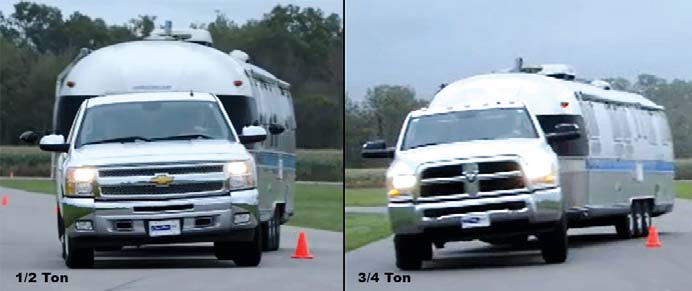
Let’s begin by taking a look at the power aspect. The large diesels from all of the manufacturers produce amazing power. At the 2015 Truck King Challenge we had three 14,000-pound Mobile Suites fifth wheels connected to the big three trucks, and we were running drag races with them at the Grand Bend Motorplex. We were doing 21-second quarter miles with the trailers on, which is just amazing! But that’s the optimum performance situation, and for normal RV touring, the question is do you really need to do 21-second quarter miles with a 14,000 pound fifth wheel attached? To get this outrageous acceleration, these engines are very expensive to buy and not inexpensive to maintain. They are extremely complex, so the days of buy-ing a big diesel for economy of operation are over. The decision to go for a diesel is all about power, and the feeling you get when you just touch the throttle and the rig surges forward is irresistible to many drivers. The engine that is likely better suited to RV towing is the 5.0 litre Cummins that is in the Nissan Titan. This engine produces 75 more horsepower and 55 pounds more torque than the first Duramax diesels did. The Titan is a basi-cally a three-quarter ton truck with a light rear axle, if it had a 6,500-pound rear axle it would be ideal for most fifth wheels.
Another thing people like about the big power is that they feel like the truck is never working hard, of course it is, but it just doesn’t feel that way. They like the power because they almost never shift down on hills and they can tow in 6th gear all the time. I kind of wonder when shifting gears in an automatic transmission got to be so hard? The other issue is that when you are towing in 6th gear and that is the tallest gear, it means the truck should be geared taller so that 6th gear is for solo use and you could tow in 4th or 5th. After all, you will drive many more miles without the trailer than with it. Do you need that massive engine turning extra RPM for all those solo miles? For our three-quarter ton company truck that is used solely for towing big fifth wheels we run a gas engine, I just can-not make the numbers work for the diesel. I delivered a loaded 15,500- pound Mobile Suite fifth wheel to Florida a few years ago with our 2008 Dodge with a 5.7 Hemi; on a few occasions on I-75 it dropped to 50 MPH, and once on an uphill run it dropped to 45 MPH. A diesel would have done those climbs at 60 MPH but is it so bad to slow down a little on a hill once in a while?
For any trailer that a half-ton can carry there are gas engines with an abundance of power to pull them. Todays 3.5 L Eco Boost, Hemi’s, and the 6.2 GM are very hot motors. With the 6-speed and 8-speed transmissions they almost always have the right gear for the job.
So you might be saying to yourself – okay, a 350 HP gas engine has enough power but isn’t a three-quarter ton pickup safer? After all, if it is heavier and has a bigger number on the fender it must be safer – right? Well, maybe not. The only three-quarter and one ton trucks with independent front suspension are GM’s and two-wheel drive Fords. Dodge Rams used to have independent front suspension on their two-wheel drives, but now even those are live axles. There is sim-ply no way to make a live axle handle as well as an independent suspension; the un-sprung weight, narrower stance, limited suspension travel and vague steering feel just can’t be compensated for. In addition to this, since the straight live axle has to clear the bottom of the engine, the truck has to sit much higher in the air, raising its already tall centre of gravity even higher.
RIDE AND SUSPENSION
Every half-ton has independent front suspension and they generally sit a little lower as well. Of course, the rear suspension is a live axle – but it is lighter so there is a little less un-sprung weight and some models have the shocks outboard of the frame which helps as well. Steering feel is much better, especially with precise handling tires.
Where half-tons are often not as good is in the tire and wheel selection and soft suspension. It is funny how in the 70’s and 80’s a Cadillac had a very soft mushy suspension and a half-ton truck had a relatively firm suspension. As we moved through the 80’s and 90’s, trucks sold better if they rode soft and Cadillacs became sport sedans with firm dialed-in suspensions – so today we have soft mushy half-tons and firm Caddies. My father would think the whole world has turned upside-down!
New sport sedans may feel firm, but they don’t have hard springs; what makes them firm are very controlled shock absorbers and precise tires. A new Corvette is very softly sprung, but out-handles its very harshly sprung ances-tors. So the soft springs in a half-ton are not so bad, because we can add control without making the ride overly harsh. To add control to a half-ton you install higher quality shock absorbers such as Monroe Gas Magnum or Bilstein. The next step is to install firmer tires. 17” and 18” passenger car tires on comparatively narrow rims have substantial sidewall roll, so tightening these up makes a dramatic improvement. These can be changed to narrower LT tires or a truck performance tire depending on the size and load carrying requirements. It truly is amazing the difference that tire size and construction can make. Many of the new trucks come with 20” rims which are also wider, and these handle better but can still be improved upon if you want more precise handling. So we rarely touch the springs on a half-ton – about the only time we change springs is if the owner is carrying more than 500 pounds in the back before adding the trailer, or if they are towing fifth wheels that will put them close to the axle capacity.
With better tires and shocks, we wind up with a firmer riding truck than the standard half-ton, but still far smoother than a three-quarter tom pickup, especially one with a live front axle. At the same time, we get more controlled, precise handling, resulting in better accident avoidance capability than the three-quarter ton. Now these changes cost some money, but the half-ton is $7-10,000 less expensive than a gasoline three-quarter ton model, and $20,000 less than a three-quarter-ton diesel, and it will use less fuel, so in the end it is still a far less expensive truck to own and operate. What we suggest is to buy the half-ton and if you are not satisfied with the handling and you have 17” or 18” rims do the tires first: if you have 20” rims, do the shocks first, and then go to the second step if you find you need to. Having driven the half-and three-quarter ton pickups often in both trims, I find that great shocks and tires are well worth the small cost difference. If you are towing a light fifth wheel with the half-ton, the stock tires will be fine, but better shocks will help a great deal.
BRAKING
One other safety related concern is braking. Today, half-tons have almost the same size brakes as a three-quarter ton model, and the truck itself is lighter. Also, many of the tires useable on a half-ton have considerably more traction, so the half-ton will actually stop more quickly than the three-quarter ton truck.
Engine braking can help. All modern diesels have an exhaust brake to use on steep long downhill grades because a diesel does not produce much engine braking without one. A gas engine does not need one because it has a throttle to close off air to the engine. A gas engine will need to turn at a higher RPM to get good engine braking at least 3500 but that is fine – just downshift it and let it hold your rig at the correct speed for the road conditions.

PAYLOAD
The last question is payload capacity. Most of the standard half-tons list their payload capacity between 1500 and 1800 pounds. Generally, this number is pretty well equal to the available capacity on the rear axle. Recently, I weighed a Ram 1500 – the rear axle dry weight was 2250 pounds and it is rated at 3900 pounds, so in theory you could add 1650 pounds to the rear axle before overloading it. Fuel is going to put a couple of hundred pounds on the rear axle, so you wind up with close to the 1430 pounds of payload listed for the truck. 1430 pounds is also pretty close to the difference between the base weight of the pickup (5320 pounds) and the list GVWR (Gross Vehicle Weight Rating) of 6,800 pounds.
So in theory, you should never carry more than 1430 pounds in this truck… or should you? The front and rear axles are both rated to carry 3900 pounds so the truck can easily carry 7800 pounds if you could distribute the weight to the front wheels. Chrysler knows that this is impossible, since all the carrying space is at the back, with quite a lot of it actually behind the rear axle. However, when we tow a travel trailer we can carry any weight behind the axle because we use a properly set-up weight distributing hitch that transfers some of the weight to the front axle.
The Ram 1500 described above was connected to a 33’ travel trailer that has 1,075 pounds of hitch weight. The truck had the customer’s normal gear in the box and 3 adult passengers. On the road the combination drove very nicely, with no feeling of being overloaded and the truck was perfectly level. The rear axle of the truck was carrying 3780 pounds and the front axle carried 3660. So neither axle was overloaded, and the tires were rated for 4370 pounds per axle so they had plenty of leeway. So even though the truck was 640 pounds over its GVWR nothing was overloaded, and the truck was stable with plenty of leeway on any item that matters.
All of these factors go into selecting a great RV towing combination, but there is a strong temptation to narrow it down to one number. Numbers matter to a certain degree, but not one spec at the expense of many other more important factors. So if you like the feel of a three-quarter ton pickup and you can afford it, by all means get one – but unless you are towing a larger fifth wheel, don’t feel that you absolutely have to have the higher capacity pickup. When you look at this chart you may feel uncomfortable about the -640 compared to GVWR.
THE BOTTOM LINE…
Is it worth possibly giving up independent front suspension, raising your centre of gravity and having a much heavier vehicle to stop and turn, just to satisfy an arbitrary number that does not actually matter when towing?






